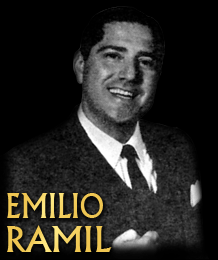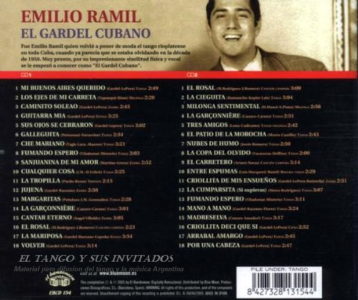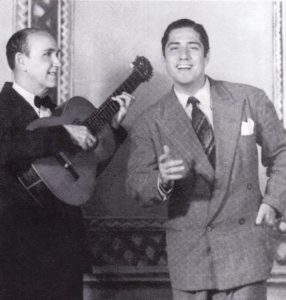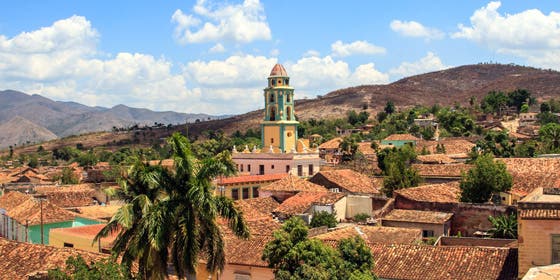 EL TANGO IN CUBA AND THE STORY OF EMILIO RAMIL, “EL GARDEL CUBANO”. VIDEOS.
EL TANGO IN CUBA AND THE STORY OF EMILIO RAMIL, “EL GARDEL CUBANO”. VIDEOS.
Curiously, el Tango arrived in Cuba when its music began to languish, although never dying, in the late 1940s and early 1950s. It comes from the hand of Spanish singers such as Juan Pulido and Jose Moriche, but mainly distinguishing their beautiful notes with the inspiring voice recorded by the tango giant, Carlos Gardel, and the never-forgotten Trio Argentino, formed then by Agustin Irusta, Lucio Demare, and Roberto Fugazot who in 1948 gave us their beautiful melodies.
Argentine performers of el Tango, from the 30s to the 50s appeared in a large number. They were all successful, among them, were Hugo Del Carril, Alberto Gómez, and Libertad Lamarque. Furthermore in Cuba, the movies and the radio were very important in spreading tango. Argentine movies were premiered monthly and radio stations aired that music around the clock.
Also, the tango embassies in Cuba influenced the musical taste of Emilio Ramil, a Cuban singer born in the Barrio del Cerro, La Habana and who from a young age begins to interpret the old tangos, already in fashion heard in Cuba.
START OF EMILIO RAMIL, “EL GARDEL CUBANO”.
His case was quite different from the ones of his Cuban peers and, Ramil himself admits that his figure, his voice range, and his phrasing made people be amazed in such a way that they mistook him for the Zorzal Criollo himself.
His professional debut was in 1949. The Trío Landa, Llerena, and Tabranés invited him to sing at the Radio Cine of La Habana and, on that occasion, he sang famous tangos of the Gardel’s songbook and shared the bill with the Dolly Sisters who played mambo.
Time later, when he was a professional, he was backed up by the orchestra led by Bebo Valdés with a contract with the Compañía Arredondo to make a tour throughout the island. By that time he cut his first record for the Puchito label.
The guitarist Roberto de Moya introduced him to the guitarists Agustín Cornejo and Carlos Spaventa (who had accompanied Gardel) and, together, they recorded “El Rosal” and “La Cieguita”.
His popularity grew and he appeared at the Ali Bar, Sierra Bar, and Mi bohío. Three of the most outstanding night clubs in La Habana. He appeared at the theaters Negrete, Reina, Fausto, and many others more. He sang tango numbers at the Tropicana, in the play Serenata Gaucha by the choreographer Rodney (Roderico Neyra). At the Show del Mediodía he sang “Caminito soleado” along with the Conjunto Casino which allowed him to sign for CMQ Televisión.
Ramil thinks that television helped him to be well known and successful with the audience, as he himself recalls: “I think that much of the tango revival I made in Cuba was mainly due to that wonderful invention called television. Because by appearing so often on CMQ-TV, which with its branches reached the whole island, my figure and voice were widely popular”. To such an extent he was recognized that the drivers of the public buses did not let him pay his ticket and used to tell him: “How can we dare to collect from the Cuban Gardel”
“EL GARDEL CUBANO” TRAVELS ABROAD.
In 1953 he was hired to sing for the first time abroad: New York, in the United States. On his comeback to Cuba, he reached his peak around 1955. That year he would leave for good.
That year, in one of his last performances in the CMQ-TV studios, the lyricist Horacio Sanguinetti was present. The latter, after listening to him, suggesting him going to Argentina and, precisely, to Radio Belgrano. «There you’ll find your consecration». And so he did. He sent recorded material to Buenos Aires and he was hired to appear for several weeks. He appeared to great acclaim on radio, television, and several clubs which allowed him to extend his contract for a year. There he had a chance to meet and sing with Agustín Magaldi Jr.
Before departing from Cuba he made a short tour of Miami and New York. He did not travel immediately to Argentina because there was news about a coup d’etat that had overthrown president Juan Perón. Regretfully, in the United States, he did not reach the acclaim he expected and, when he knew the revolution was ended, he then decided to travel to Buenos Aires.
After his appearances on Radio Belgrano in a program sponsored by Jabón Manuelita, (a very popular soap), he was on television and at a well-remembered performance at the Parque Genovés of the neighborhood of Pompeya. During his stay, he visited Gardel’s graveyard and left a bunch of flowers. He was accompanied by Guillermo Barbieri’s widow and the wife of the jockey Irineo Leguisamo who was the ones in charge of the keys of the vault.
When his contract with Radio Belgrano was over he was hired by Radio Splendid that wanted to compete with the former radio station which was then spotlighting the vocalist Horacio Deval. He also appeared in the province of Mendoza and when he returned he crossed to Uruguay hired by Radio Carve of Montevideo on which he had a one-year tenure.
On his comeback, he appeared again in Argentina and sang in Rosario (Santa Fe), and soon he was summoned from the province of Córdoba to sing on Radio LV2 in March 1957. Soon thereafter he went to Chile, hired by Radio Minería, where he stayed for many years and was a boom.
It is his fidelity to the Gardelian school that leads him to triumph as well as his interpretive quality. His constant successes are applauded in addition to Cuba and Buenos Aires, in Uruguay, Chile, Ecuador, Colombia, Peru, Puerto Rico.
He married Chilean singer Gloria Montes and in the 1960s he settled in New Jersey to retire from artistic life in 1977.
Emilio Ramil passed away on February 19, 2014, in New Jersey, Estados Unidos, but always will be remembered as “El Gardel Cubano.
 EL TANGO EN CUBA Y LA HISTORIA DE EMILIO RAMÍL, “EL GARDEL CUBANO”. VIDEOS.
EL TANGO EN CUBA Y LA HISTORIA DE EMILIO RAMÍL, “EL GARDEL CUBANO”. VIDEOS.
Curiosamente, el tango llegó a Cuba cuando su música comenzó a languidecer, aunque nunca muriera, a finales de los cuarenta y principios de los cincuenta. Viene de la mano de cantantes españoles como Juan Pulido y José Moriche, pero principalmente distinguiendo sus hermosos compases con la inspiradora voz grabada por el gigante del tango, Carlos Gardel, y el inolvidable Trío Argentino, formado entonces por Agustín Irusta, Lucio. Demare y Roberto Fugazot que en 1948 nos regalaron sus hermosas melodías.
Los intérpretes argentinos del Tango, de los años 30 a los 50 aparecieron en gran número. Todos tuvieron éxito, entre ellos, Hugo Del Carril, Alberto Gómez y Libertad Lamarque. Además, el cine y la radio fueron muy importantes en la difusión del tango. Las películas argentinas se estrenan mensualmente y las estaciones de radio transmiten esa música las 24 horas.
Asimismo, las embajadas del tango en Cuba influyeron en el gusto musical de Emilio Ramil, cantante cubano nacido en el Barrio del Cerro, La Habana y que desde muy joven comienza a interpretar los viejos tangos, ya de moda que se escuchan en Cuba.
INICIO DE EMILIO RAMIL, “EL GARDEL CUBANO”.
Su caso fue bastante diferente al de sus pares cubanos y, el propio Ramil admite que su figura, su rango de voz y su fraseo hicieron que la gente se asombrara de tal manera que lo confundieran con el propio Zorzal Criollo.
Su debut profesional fue en 1949. El Trío Landa, Llerena y Tabranés lo invitaron a cantar en la Radio Cine de La Habana y, en esa ocasión, cantó famosos tangos del cancionero de Gardel y compartió cartel con las Dolly Sisters que tocaban. mambo.
Tiempo después, cuando era profesional, fue respaldado por la orquesta que dirigía Bebo Valdés con contrato con la Compañía Arredondo para realizar una gira por toda la isla. Para entonces grabó su primer disco para el sello Puchito.
El guitarrista Roberto de Moya le presentó a los guitarristas Agustín Cornejo y Carlos Spaventa (que había acompañado a Gardel) y, juntos, grabaron “El Rosal” y “La Cieguita”.
Su popularidad creció y actuó en Ali Bar, Sierra Bar y Mi bohío. Tres de los clubes nocturnos más destacados de La Habana. Actuó en los teatros Negrete, Reina, Fausto y muchos otros más. Cantó temas de tango en el Tropicana, en la obra Serenata Gaucha del coreógrafo Rodney (Roderico Neyra). En el Show del Mediodía cantó “Caminito soleado” junto al Conjunto Casino lo que le permitió fichar por CMQ Televisión.
Ramil piensa que la televisión lo ayudó a ser conocido y exitoso entre la audiencia, como él mismo recuerda: “Creo que gran parte del renacimiento del tango que hice en Cuba se debió principalmente a ese maravilloso invento que se llama televisión. Porque al aparecer tan a menudo en CMQ-TV, que con sus sucursales llegaba a toda la isla, mi figura y mi voz fueron muy populares ”. Hasta tal punto se le reconoció que los choferes de los buses públicos no le dejaban pagar su boleto y solían decirle: “¿Cómo podemos atrevernos a cobrarle al Gardel cubano?”
“EL GARDEL CUBANO” VIAJA AL EXTRANJERO.
En 1953 fue contratado para cantar por primera vez en el extranjero: Nueva York, en Estados Unidos. A su regreso a Cuba, alcanzó su punto máximo alrededor de 1955. Ese año se iría para siempre.
Ese año, en una de sus últimas actuaciones en los estudios CMQ-TV, estuvo presente el letrista Horacio Sanguinetti. Este último, tras escucharlo, sugirió que se fuera a Argentina y, precisamente, a Radio Belgrano. «Allí encontrarás tu consagración». Y así lo hizo. Envió material grabado a Buenos Aires y fue contratado para presentarse por varias semanas. Apareció con gran éxito en la radio, televisión y varios clubes, lo que le permitió extender su contrato por un año. Allí tuvo la oportunidad de conocer y cantar con Agustín Magaldi Jr.
Antes de partir de Cuba realizó una pequeña gira por Miami y Nueva York. No viajó de inmediato a Argentina porque hubo noticias sobre un golpe de estado que había derrocado al presidente Juan Perón. Lamentablemente, en Estados Unidos no alcanzó la aclamación que esperaba y, cuando supo que la revolución había terminado, decidió viajar a Buenos Aires.
Tras sus apariciones en Radio Belgrano en un programa patrocinado por Jabón Manuelita, (telenovela muy popular), estuvo en televisión y en una actuación muy recordada en el Parque Genovés del barrio de Pompeya. Durante su estadía, visitó el cementerio de Gardel y dejó un ramo de flores. Lo acompañaba la viuda de Guillermo Barbieri y la esposa del jockey Irineo Leguisamo, quien estaba a cargo de las llaves de la bóveda.
Cuando terminó su contrato con Radio Belgrano fue contratado por Radio Splendid que quería competir con la ex emisora de radio que en ese entonces destacaba al vocalista Horacio Deval. También se presentó en la provincia de Mendoza y cuando regresó cruzó a Uruguay contratado por Radio Carve de Montevideo en la que tuvo un año de permanencia.
A su regreso, se presentó nuevamente en Argentina y cantó en Rosario (Santa Fe), y pronto fue convocado desde la provincia de Córdoba para cantar en Radio LV2 en marzo de 1957. Poco tiempo después se fue a Chile, contratado por Radio Minería, donde se quedó muchos años y fue un boom.
Es su fidelidad a la escuela gardeliana lo que le lleva al triunfo así como su calidad interpretativa. Sus constantes éxitos son aplaudidos además de Cuba y Buenos Aires, en Uruguay, Chile, Ecuador, Colombia, Perú, Puerto Rico.
Se casó con la cantante chilena Gloria Montes y en la década de 1960 se instaló en Nueva Jersey para retirarse de la vida artística en 1977.
Emilio Ramil falleció el 19 de febrero de 2014 en Nueva Jersey, Estados Unidos, pero siempre será recordado como “El Gardel Cubano.
Agencies/ TodoTango/ Ricardo Garcia/ Wiki/ Extractos/ Excerpts/ Internet Photos/ YouTube/ Arnoldo Varona/ www.TheCubanHistory.com
THE CUBAN HISTORY, HOLLYWOOD.








